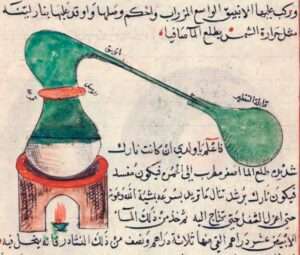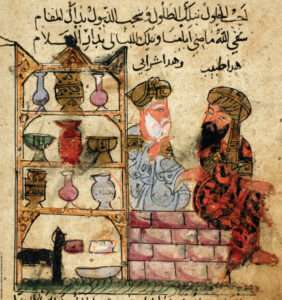We’ve all heard mystical stories and legends filled with alchemists and their unstoppable search for the elixir of life, but I am here to tell you that these stories are actually real.
Muslim civilization holds a rich and mysterious history, and one of the most fascinating aspects for me was diving deeper into the ancient works of alchemy.
A Path to Immortality?

Since Arab scholars lived in the desert at that time, they needed to find any natural substances for survival. Through their exploration, they began to crush the desert sand, turning it into a dry powder. Without any expectations, they started using this powder to cover wounds, and to their surprise, it showed fast healing effects.

But it didn’t stop there—alchemists were driven to find out how was it even possible. After much research, they realized that the powder was filled with minerals that had healing properties. This discovery happened around the 8th century, a time when people were just beginning to understand the fundamentals of life. So, after finding something that could heal the body faster, the alchemists believed they had unlocked the secrets to immortality.
So… experiment after experiment showed that this powder had to be kept a secret. The results of these experiments were recorded in complex language that only the alchemists themselves could decipher. And why did they want to keep it a secret?
Because the alchemists discovered that this mineral powder could also turn metals into gold. Then…If the powder became accessible to everyone, it would lose its value.
Jabir ibn Hayyan (c. 721–c. 815 CE): The Father of Alchemy

One of the greatest alchemists and the founder of alchemy was Jabir ibn Hayyan was an early Islamic alchemist, chemist, and scholar. He is often referred to as the father of chemistry for his pioneering work in laying the foundations of modern chemistry and alchemy.

Jabir’s contributions spanned not just chemistry but also medicine, astronomy, philosophy, and engineering. His Latinized name, Geber, became a symbol of alchemy and early chemistry in the West, where his texts were studied by scholars like Roger Bacon and Robert Boyle.
Elixir of Life
In Kufa, Iraq, about two centuries after Jabir ibn Hayyan’s death, his laboratory was discovered containing a mortar and a large piece of gold.

And do you know what this powder was called by alchemists in ancient Arabic scripture? It was called “Al-iiksir”, meaning “medium for obtaining something.” As the works of these alchemists were translated into other languages over time, the Arabic term “Al-iksir” evolved, and today we know it widely in English as “Elixir.”
So now, these mystical stories and legends turn out to be more real than we ever imagined.
